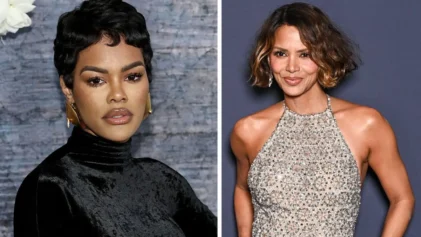Halle Berry and her ex, Gabriel Aubry, are no strangers to launching court battles over money or custody of 6-year-old Nahla, but their latest feud over Nahla’s hair prompted a passionate discussion in the Black community about the manipulation of a young Black girl’s hair.
Some people believed that the award-winning actress went too far when she sent Nahla’s brush to get tested in order to prove that Aubry had bleached her hair. But she may not be as crazy as some entertainment news sites make her out to be.
Bleaching and chemically straightening a child’s hair, especially a child of color, does have the potential to not only be harmful to her hair but to her self-esteem and perception of beauty as well, according to experts.
While this certainly may not always be the case, many parents underestimate the messages they are sending to their children if they do decide to use drastic measures to change their child’s appearance.
Debates are still going on about what methods Aubry even used to straighten Nahla’s hair and whether or not he actually bleached it, but this isn’t the first time that this topic sparked controversy in the Black community.
Many parents chemically straighten their child’s hair in order to make it easier to manage, while others just have fun experimenting with different looks.
What they don’t realize is that the constant manipulation could come at a great cost.
“In the instance of a child’s hair, if major changes such as a chemical relaxer, color highlights, extreme haircuts, and/or extensions are made because the belief of the parent/caregiver is that his/her child’s hair is ‘bad,’ ‘nappy,’ ‘hard to manage,’ or not the ‘right’ texture, length or color, it is has the potential to send a negative message that can be internalized,” Dr. Garica Sanford, a clinical psychologist in Texas who has spent years in the field working with children and helping parents understand their child’s behavior and emotions, told Atlanta Blackstar. “Children may begin to feel that their features are less attractive than that of other children, which can ultimately impact how they learn to view themselves. Furthermore, if the features that are being criticized or changed are connected to aspects of the racial or cultural identity, it may extend to how they feel about other aspects of their identity.”
Berry never said that she was afraid of Aubry “turning our daughter white,” but media outlets certainly focused on that angle and many of the actress’s fans do believe that that was her real concern.
At only 6-years-old, Nahla is navigating a time in her life when she is very impressionable and many parents should realize that conversations about race and racial identity should not wait until adolescence.
“Children are very impressionable and truly soak up information from their environment,” Dr. Sanford added. “Given children are increasingly exposed to external influences about their appearance from peers and the media, it is extremely important for parents to reinforce their child’s internal strengths as well as affirming their self-image at an early age…This can be even more important for Black children given that these external influences often may not look similar to their own appearance.”
America is still a society that seems to focus on light skin, long, straight hair and petite body frames as the ideal image of beauty.
In mainstream media, particularly shows for children, Black characters are hard to come by and many of them are rarely seen with natural hair, which could relay a message to young Black girls that their natural hair is “wrong.”
“The reality is that we are not color blind; children will learn to notice that peers look different at very early ages,” Dr. Sanford said. “However, parents can help them learn what meaning to attach to these differences. For example, when a child begins to notice that Sally’s hair is longer, lighter or straighter than their own hair, it is important to talk about these differences in a way that communicates appreciation for differences, and not a need to try to be similar.”
While some members of the Black community are still struggling to place a label on early hair manipulation as right or wrong, Dr. Sanford said the real discussion should be about a parent’s intentions rather than the action itself.
“It is important for caregivers to ask themselves why they are making such a decision, as well as consider how they are explaining or talking about the choice to the child,” Dr. Sanford said. “For example, the choice to straighten a child’s hair in itself may not necessarily have a negative impact on what the child learns to think about themselves and his or her hair.”
She explained that there is a difference between straightening the child’s hair for a certain occasion versus refusing to ever let a child wear or embrace their natural hair texture.
If a child sees straight hair as a styling option it won’t be detrimental to their perception of beauty and racial identity because they will see it as just that—an option.
When it comes to hair color, a child’s health could be more important than anything else.
Dr. Sanford said parents should always consult with a licensed beautician to discuss the “possible long-term impacts” on the child’s hair.
“Furthermore, when considering any type of chemical treatment for a child’s hair, it is important to be cognizant of other factors such as possible skin sensitivities, and even consider consultation with a dermatologist,” she said.
Defining hair manipulation for children as right or wrong is a nearly impossible task because that label will always be a subjective one, but it is absolutely essential that parents have open conversations with their children about the differences they will start to notice between their own appearance and those of other children of different backgrounds.


